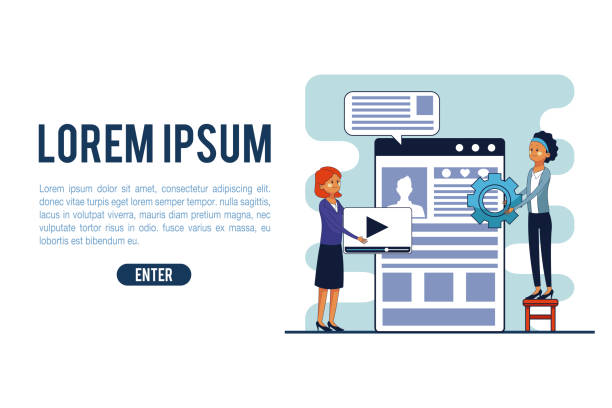An Introduction to the Necessity of #Multilingual_Website_Design in the Global Era

In today’s world, where geographical boundaries have faded in the digital space, a powerful presence in the international arena is vital for every business.
This is where the importance of #multilingual_website_design becomes more apparent than ever.
A multilingual website is a bridge that connects you to new markets, potential customers worldwide, and different cultures.
This approach not only increases audience reach but also enhances your brand’s credibility and professionalism.
Without such a capability, countless opportunities for growth and development are overlooked.
The goal of this descriptive article is to provide a step-by-step and analytical guide on various aspects of website design, with a focus on a multilingual approach, to prepare you for entry into this field.
Tired of losing business opportunities due to not having a professional corporate website? Worry no more! With Rasaweb’s corporate website design services:
✅ Your brand’s credibility and professionalism will increase.
✅ You will attract more customers and sales leads.
⚡ Get a free consultation now to start!
Competitive Advantages of Multilingual Websites and Market Expansion

A multilingual website not only allows you to connect with more audiences but also brings significant competitive advantages.
Among the most important of these benefits are increasing market share and reaching new customers.
When your site’s content is available in users’ native language, the Conversion Rate significantly increases because user trust and comfort are higher.
Research has shown that most users prefer to make purchases or interact on a website that offers content in their own language.
This allows you to penetrate deeper into local markets and make competition more difficult for single-language rivals.
This section analytically and instructively examines how to maximize these benefits.
Multilingual website design, as a business development strategy, creates significant long-term value and brings a substantial return on investment.
Technical Challenges and Implementation Solutions for a Multilingual Website

Implementing a multilingual website goes beyond mere content translation and has its own specific technical challenges.
One of the most important challenges is managing URL structure and how languages are addressed.
Using subdirectories (like yoursite.com/en/), subdomains (en.yoursite.com), or country code top-level domains (ccTLDs) (yoursite.co.uk) all have their advantages and disadvantages that must be chosen in accordance with SEO and brand strategy.
Additionally, supporting different writing systems such as Right-to-Left (RTL) for languages like Persian and Arabic is another technical issue that requires appropriate CSS and HTML design.
This specialized section provides the necessary guidance to overcome these challenges.
Furthermore, attention must be paid to issues related to databases and multilingual content storage to maintain site efficiency and speed.
Multilingual website design, taking into account these technical details, ensures stability and optimal performance.
Below is a comparative table of language addressing methods:
| Addressing Method | Advantages | Disadvantages | Recommended Use |
|---|---|---|---|
| Subdirectory | Strong SEO, easy management, lower cost | Potential complexity in very large projects | Most websites |
| Subdomain | Different hosting possibilities, geographical separation | Requires separate SEO for each subdomain | Large companies with independent sections |
| Country Code Top-Level Domain (ccTLD) | Strongest geographical signal, high trust | High cost, more complex management | Large brands with high budgets and strong local focus |
The Importance of SEO in Multilingual Websites and Its Strategies

SEO (Search Engine Optimization) in multilingual websites is a specialized field that requires special attention.
Merely translating content is not enough; it is crucial to ensure that search engines can identify and correctly index each language version.
Using hreflang tags in the HTML header or in the Sitemap to guide search engines to different language versions of a page is vital.
These tags help prevent duplicate content from being mistakenly identified and direct users to their appropriate language version.
Keywords must also be researched and localized separately for each language, rather than just translated, as search behavior varies across different cultures.
This educational and guidance section helps you implement a more effective multilingual SEO strategy.
Furthermore, attention should be paid to page loading speed in different geographical regions and the use of a CDN (Content Delivery Network) to improve user experience and boost SEO rankings.
Multilingual website design without a strong SEO strategy practically loses a large part of its potential.
Tired of losing customers due to poor e-commerce website design? With Rasaweb, solve this problem forever!
✅ Increase sales and conversion rates from visitors to customers
✅ Smooth and engaging user experience for your customers⚡ Get a free consultation
Implementation Tools and Suitable Platforms for Multilingual Design

Choosing the right tools and platform for multilingual website design is a crucial step towards project success.
Content Management Systems (CMS) like WordPress with plugins such as WPML or Polylang, Drupal with its built-in multilingual capabilities, or Joomla, each offer powerful solutions.
These tools facilitate easy management of translated content, language switching, and compatibility with multilingual SEO.
Platform selection should be based on specific project needs, budget, and the development team’s expertise.
Some platforms are more suitable for small and medium-sized websites, while others are designed for large organizations with high content volume and complex customization requirements.
This educational section descriptively examines the available options and provides guidance for optimal selection.
Additionally, using AI-powered translation tools can accelerate the initial translation process, but human review is always needed to ensure accuracy and cultural appropriateness.
Facilitating the multilingual website design process with the right tools leads to optimization of time and resources.
The Importance of Cultural Content and Localization Beyond Translation

Localization in multilingual website design means going beyond mere literal translation.
Your content must not only be linguistically correct but also culturally appropriate for the target audience.
This includes adapting terminology, units of measurement, dates, numerical formats, colors, images, and even examples and stories.
Entertaining or educational content in one culture might be irrelevant or even offensive in another.
For instance, the use of red in China symbolizes good luck, while in some Western cultures, it might be associated with danger or warning.
This analytical and thought-provoking section helps you produce content that truly connects with your global audience and conveys a sense of nativeness by deeply understanding cultural differences.
Consulting with local experts in each target market can be highly beneficial in this regard.
Ensuring cultural appropriateness is a key element in the long-term success of a multilingual website and significantly improves user experience.
Multilingual Website Management and Maintenance: Challenges and Solutions

After launch, managing and maintaining a multilingual website becomes an ongoing process with its own specific challenges.
Updating content in all languages, ensuring consistency across different versions, and addressing potential translation or display errors are among the important responsibilities.
Monitoring SEO performance in each language and making necessary optimizations based on Google Analytics and Google Search Console data for each language version is crucial.
Establishing a regular maintenance plan that includes checking broken links, updating plugins and themes, and security monitoring is essential for preserving site health and efficiency.
This specialized and guidance section provides you with practical insight into how to effectively manage a dynamic and successful multilingual website design.
Additionally, training the content team to work with the multilingual system and understand the importance of coordination is another key aspect.
Below is a checklist table for multilingual website maintenance:
| Maintenance Factor | Description | Recommended Frequency |
|---|---|---|
| Content Update | Translate and upload new content in all languages | Weekly/Monthly (depending on content production rate) |
| SEO Monitoring | Check keyword rankings, organic traffic for each language | Monthly |
| Broken Link Check | Ensure all internal and external links function correctly | Quarterly |
| Platform and Plugin Updates | Maintain CMS core and multilingual plugins | Monthly/Whenever a new update is released |
| Backup | Create backup copies of the entire site (files and database) | Daily/Weekly |
Examining User Experience (UX) in a Multilingual Environment

User Experience (UX) gains additional importance in multilingual website design.
Ensuring that users can easily find and select their desired language is the first step.
The location and appearance of the Language Switcher should be prominent and accessible, usually in the header or footer of the site.
Furthermore, it is important that changing the language does not result in reloading the entire page, but rather that the content is displayed quickly and without disruption.
The visual design (UI) should also be compatible with every language; for example, sufficient space for longer texts in specific languages or support for various fonts.
This guiding and specialized section emphasizes the importance of user testing with native speakers of each language to identify and resolve potential weaknesses in the user experience.
A strong UX increases customer loyalty and ensures user retention.
Successful multilingual website design should always place user experience at its core, so that global audiences feel comfortable and connected.
Are you losing potential customers due to an unprofessional website? Rasaweb is your answer! With our specialized corporate website design services:
✅ Enhance your business’s credibility and standing
✅ Experience attracting more targeted customers
⚡ Act now to get a free consultation!
The Future of Multilingual Website Design: Emerging Trends and Artificial Intelligence

The future of multilingual website design hinges on technological advancements and emerging trends.
One of the most significant of these trends is the integration of Artificial Intelligence (AI) into translation and localization processes.
While machine translation alone is not yet a substitute for human translation, AI-powered tools are becoming increasingly intelligent and can provide high-quality initial translations in a short amount of time.
This can significantly increase the speed of multilingual content production and reduce costs, although the need for human editing to maintain accuracy and appropriate tone of voice will remain.
Recent news reports indicate that major companies are investing heavily in this area.
In addition to AI, the emergence of new technologies like WebAssembly and Progressive Web Apps (PWAs) can also help improve performance and user experience on multilingual websites.
This analytical and engaging section examines how these technologies impact multilingual website design and what can be expected from it in the future.
The intelligent automation of website multilingualization opens new horizons for global online presence.
Conclusion and Next Steps for Global Presence

In this article, we descriptively, explanatorily, and analytically examined the necessity and various dimensions of multilingual website design.
From competitive advantages and technical challenges to the importance of SEO, cultural localization, management and maintenance, and the future of this field, each was discussed in detail.
A multilingual website is more than just a website; it is a gateway to global markets and communication with diverse audiences.
To embark on the path of successful multilingual website design, you must first accurately identify your target audience and required languages.
Then, begin the implementation process by choosing the right platform and a precise SEO strategy.
Finally, by localizing content and planning for continuous maintenance, ensure the long-term stability and success of your site.
With this comprehensive approach and guidance, your business can have a powerful and effective presence on the international stage and benefit from the countless opportunities that the digital world offers.
Investing in professional multilingual website design is a smart step towards sustainable growth and development.
Frequently Asked Questions
| Question | Answer |
|---|---|
| What is a multilingual website? | A website whose content is available to users in more than one language. |
| Why should I make my site multilingual? | To reach a larger audience in global markets, improve user experience, and boost international SEO. |
| What are the technical approaches to building a multilingual site? | Using subdirectories, subdomains, or URL parameters to separate languages. |
| What effect does multilingual design have on SEO? | By targeting local keywords and providing content in users’ native language, the site’s ranking in search engines for those regions improves. |
| What are the challenges of multilingual website design? | Content translation management, Right-to-Left (RTL) direction support, technical issues related to language addressing, and maintaining design consistency. |
| How do we choose the languages for a multilingual site? | Based on target audience analysis, target markets, and current site traffic data (if available). |
| What is RTL support and why is it important for some languages? | Right-to-Left, the direction of text and page elements from right to left, which is essential for languages like Persian, Arabic, and Hebrew. |
| How do we manage multilingual site content? | Using Content Management Systems (CMS) with multilingual capabilities, translation plugins, or professional translation services. |
| How is User Experience (UX) in a multilingual site? | The ability to easily change languages must be provided, and translated content must be of high quality for users to feel comfortable. |
| What are the common CMS platforms for multilingual sites? | WordPress (with plugins like WPML), Joomla, Drupal, and Shopify (with relevant settings or plugins). |
And other services of Rasa Web Advertising Agency in the field of advertising
Smart Advertising Campaign: Transform customer acquisition with key page optimization.
Smart Social Media: A professional solution for increasing sales with a focus on intelligent data analysis.
Smart Brand Identity: Professional optimization for SEO ranking improvement using real data.
Smart Google Ads: A combination of creativity and technology to boost sales through key page optimization.
Smart Custom Software: A dedicated service for growth in customer behavior analysis based on custom programming.
And over a hundred other services in the field of internet advertising, advertising consultation, and organizational solutions
Internet Advertising | Advertising Strategy | Advertorial
Resources
Multilingual Website Design and Business Expansion
Comprehensive Guide to Multilingual Website Design
The Importance of Multilingual Websites in Global Expansion
Advantages of Multilingual Website Design for International Business
❓ For your business to leap forward in the digital space, Rasaweb Afarin Digital Marketing Agency, specializing in SEO, targeted content marketing, and user-friendly website design, is your guide to success.
📍 Tehran, Mirdamad Street, next to Bank Markazi, Kazerun Jonubi Alley, Ramin Alley, P.O. Box 6




